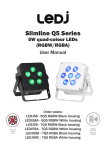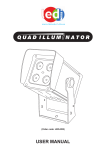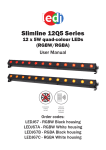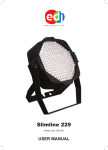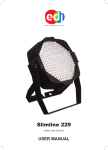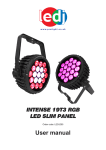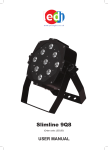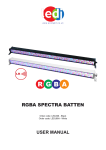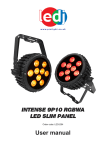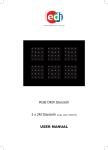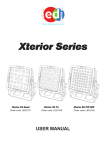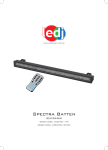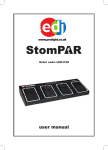Download Slimline 5Q5 Slimline 7Q5
Transcript
w w w. p r o l i g h t . c o . u k Slimline 5Q5 Order code: LEDJ58 - Black (RGBW) Order code: LEDJ58A - White (RGBW) Slimline 7Q5 Order code: LEDJ59 - Black (RGBW) Order code: LEDJ59A - White (RGBW) Order code: LEDJ59B - Black (RGBA) Order code: LEDJ59C - White (RGBA) USER MANUAL LEDJ Slimline 5Q5, 7Q5 Safety WARNING FOR YOUR OWN SAFETY, PLEASE READ THIS USER MANUAL CAREFULLY BEFORE YOUR INITIAL START-UP! CAUTION! Keep this equipment away from rain, moisture and liquids. SAFETY INSTRUCTIONS Every person involved with the installation, operation & maintenance of this equipment should: - Be competent - Follow the instructions of this manual CAUTION! TAKE CARE USING THIS EQUIPMENT! HIGH VOLTAGE-RISK OF ELECTRIC SHOCK!! Before your initial start-up, please make sure that there is no damage caused during transportation. Should there be any, consult your dealer and do not use the equipment. To maintain the equipment in good working condition and to ensure safe operation, it is necessary for the user to follow the safety instructions and warning notes written in this manual. Please note that damages caused by user modifications to this equipment are not subject to warranty. LEDJ Slimline 5Q5, 7Q5 Safety IMPORTANT: The manufacturer will not accept liability for any resulting damages caused by the non-observance of this manual or any unauthorised modification to the equipment. • Never let the power-cable come into contact with other cables. Handle the power-cable and all mains voltage connections with particular caution! • Never remove warning or informative labels from the equipment. • Do not open the equipment and do not modify the equipment. • Do not connect this equipment to a dimmer-pack. • Do not switch the equipment on and off in short intervals, as this will reduce the system’s life. • Only use the equipment indoors. • Do not expose to flammable sources, liquids or gases. • Cleaning must be done at regular intervals. • Before cleaning, wait until the unit has cooled. • Use a vacuum or dry compressed air and a soft brush to remove the dust collected on the external vents and accessible internal components. • Clean the external surfaces with a mild solution of non-ammonia glass cleaner or isopropyl alcohol and wipe with a soft, lint free cotton cloth or lense cleaning tissue. • Always disconnect the power from the mains when equipment is not in use or before cleaning! Only handle the power-cable by the plug. Never pull out the plug by pulling the power-cable. • Make sure that the available voltage is between 100V-240V. • Make sure that the power-cable is never crimped or damaged. Check the equipment and the power-cable periodically. • If the equipment is dropped or damaged, disconnect the mains power supply immediately. Have a qualified engineer inspect the equipment before operating again. • If the equipment has been exposed to drastic temperature fluctuation (e.g. after transportation), do not switch it on immediately. The arising condensation might damage the equipment. Leave the equipment switched off until it has reached room temperature. • If your product fails to function correctly, discontinue use immediately. Pack the unit securely (preferably in the original packing material), and return it to your Prolight dealer for service. • Only use fuses of same type and rating. • Repairs, servicing and power connection must only be carried out by a qualified technician. THIS UNIT CONTAINS NO USER SERVICEABLE PARTS. • WARRANTY; One year from date of purchase. OPERATING DETERMINATIONS If this equipment is operated in any other way, than those described in this manual, the product may suffer damage and the warranty becomes void. Incorrect operation may lead to danger e.g.: short-circuit, burns, electric shocks, LED failure etc. Do not endanger your own safety and the safety of others! Incorrect installation or use can cause serious damage to people and property. LEDJ Slimline 5Q5, 7Q5 Technical specifications You should find inside the LEDJ carton the following items: 1, Slimline 5Q5 or 7Q5 Technical Specifications: 2, Instruction manual DMX channels: 2, 3, 4 or 7 selectable 400Hz refresh rate 4 push button menu with LED display Beam angle: 25 degrees 5 or 7 x 5W quad-colour LEDs Optional I.R. remote (LEDJ90C) 7Q5 Convection cooled 45W Power consumption: 100-240V~50/60Hz Power supply: 202 x 99 x 224mm Dimensions: 2.5Kgs Weight: Operating modes: 1, Static colour mix mode 2, Built-in programmes 3, Slave mode 4, Sound active mode 5, DMX mode 6, DMX channel mode Overview: Power Out MODE ENTER UP DMX IN DOWN www.prolight.co.uk DMX OUT 3, Power cable 5Q5 38W 100-240V~50/60Hz 202 x 99 x 224mm 2Kgs LEDJ Slimline 5Q5, 7Q5 Operations 1a, RGBW colour mix mode In this mode you can set the 5Q5 or 7Q5 to any colour and any brightness. Press the “MODE” button to show “r- - -” with three digits after it. The “r” represents Red, “G” = Green, “b” = Blue, “U” = White and “F-0” = strobe. The three digits after it are the brightness 000 to 255 or in “F-0” they are the strobe speed. Examples: If you set “r”, “G”, “b” and “U” all to zero, your unit will have no LEDs showing (blackout). If you set “r” to 255 and “G”, “b” and “U” to zero your unit will be 100% Red. 1b, RGBA colour mix mode In this mode you can set the 7Q5 RGBA to any colour and any brightness. Press the “MODE” button to show “r- - -” with three digits after it. The “r” represents Red, “G” = Green, “b” = Blue, “A” = Amber and “F-0” = strobe. The three digits after it are the brightness 000 to 255 or in “F-0” they are the strobe speed. Examples: If you set “r”, “G”, “b” and “A” all to zero, your unit will have no LEDs showing (blackout). If you set “r” to 255 and “G”, “b” and “A” to zero your unit will be 100% Red. 2 Built-in programme mode Press the “MODE” button to show “Pr00” on the LED display. Press the “ENTER” button and use the “UP” and “DOWN” buttons to scroll through the 21 built-in programmes. Now press the the “ENTER” button again to change the speed from SP-0 to SP-9 using the “UP” and “DOWN” buttons. Now press the ENTER” button a final time to add strobe from F-0 to F-9. Built-in programme list: Pr00 = Colour fade/colour change Pr01 - Pr15 = Static colours (15 in total) Pr16 = 15 colour change Pr17 = 15 colour fade Pr18 = 4 colour change Pr19 = 4 colour fade Pr20 = 3 colour change 3, Slave mode Link the units together using a 3-pin DMX cable, then press the MODE button to select one of the above modes. On the Slave units press the mode button until the LED display shows “SLAV”. The Slave units will then follow in sequence with the Master unit. 4, Sound active mode Press the “MODE” button until the LED display shows “SU00”, then press the “ENTER” button to set the desired sensitivity level using the “UP” and “DOWN” buttons. The sound sensitivity levels are from 00-99 (00 = low, 99 = high) LEDJ Slimline 5Q5, 7Q5 Operations 5), DMX Addressing mode To access the DMX address mode, press the “MODE” button until the LED display shows “A001”, then using the “UP” and “DOWN” buttons you can set the DMX address. Please follow the DMX channel assignment and function table overleaf. 6), DMX channel mode To select one of the DMX channel modes, press the “MODE” button until the LED display shows “A001”, press the “ENTER” button and use the “UP” and “DOWN” buttons to select either one of the 2, 3, 4 or 7 channel DMX modes and press the “ENTER” button to confirm your choice. Note: The speed settings for the built-in programmes are from 0 - 9 - 255 (0 = off, 9 = fast). The strobe speed settings for the built-in programmes and colour mix modes are from 0 - 9 (0 = off, 9 = fast). Note: After 30 seconds of none use the LED display will blackout. To turn it back on, simply press any of the buttons. LEDJ Slimline 5Q5, 7Q5 I.R. Remote Optional I.R remote functions (LEDJ90C) Button functions: The “BLACKOUT” button is used to set the LEDs into the power on or off modes. The “S PR” button is used to run the built-in programmes. To go though the built-in programmes, press the “+” and “-” buttons. The “FL” button is used to set the LEDs to flash on and off, to change the flash frequency use the “+” and “-” buttons. The “SP” button is used to set the run speed, this button is available only in the colour change or colour fade modes. To change the speed use the “+” and “-” buttons. The “D” button is used to set the LEDs into DMX mode. (See DMX value table) The “SA” button is used to set the LEDs into sound activated mode. The “SL” button is used to set the LEDs into slave mode. The “S”, “0”, “1”, “2”, “3”, “4”, “5”, “6”, “7”, “8” and “9” buttons are used to set the DMX address for the LED’s. (see example below) The “R”, “G”, “B” and “A/W” buttons are used to set the brightness for the Red, Green, Blue and Amber/White LEDs, to change the brightness use the “+” and “-” buttons. DMX Address Examples: To set the DMX address “245”; 1) Press the “S” button, so the red LEDs come on, this means you can now start to set the DMX address. 2) Press the “2” button, so the green LEDs come on, this means the first digit “2” (the hundreds place) setting is successful. 3) Now Press the “4” button, and the blue LEDs will come on, this now means that the second digit “4” (tens place) setting is successful. 4) Now Press the “5” button, and all of the R, G, B, A/W LEDs will come on, this means that the final digit “5” (units place) setting is successful and the full DMX address setting has been changed 5) Now press the “DMX MODE” button to save the new address into memory. To set the DMX address “002”; 1) Press the “S” button, so the red LEDs come on, this means you can now start to set the DMX address. 2) Press the “0” button, so the green LEDs come on, this means the first digit “0” (the hundreds place) setting is successful. 3) Now Press the “0” button, and the blue LEDs will come on, this now means that the second digit “0” (tens place) setting is successful. 4) Now Press the “2” button, and all of the R, G, B, A/W LEDs will come on, this means that the final digit “2” (units place) setting is successful and the full DMX address setting has been changed. 5) Now press the “DMX MODE” button to save the new address into memory. Important notes: • Set the DMX address on each fixture before plugging into the DMX controller. • The I.R Remote is cannot be used when the fixture(s) are being controlled by a DMX controller. • The maximum transmitter distance is 10M. Please make sure that you have the I.R remote aimed directly at each fixture to be programmed, • If you do not press the “DMX MODE” button after you have changed the DMX address, when you power down the fixture it will lose the address you have set. LEDJ Slimline 5Q5, 7Q5 Slimline 5Q5 and 7Q5 RGBW DMX Charts 2 channel DMX chart 3 channel DMX chart 4 channel DMX chart 7 channel DMX chart RGBW DMX Charts LEDJ Slimline 5Q5, 7Q5 RGBA DMX Charts Slimline 7Q5 RGBA DMX Charts 2 channel DMX chart 3 channel DMX chart 4 channel DMX chart 7 channel DMX chart DMX-512: • DMX (Digital Multiplex) is a universal protocol used as a form of communication between intelligent fixtures and controllers. A DMX controller sends DMX data instructions form the controller to the fixture. DMX data is sent as serial data that travels from fixture to fixture via the DATA “IN” and DATA “OUT” XLR terminals located on all DMX fixtures (most controllers only have a data “out” terminal). LEDJ Slimline 5Q5, 7Q5 DMX Setup DMX Linking: • DMX is a language allowing all makes and models of different manufactures to be linked together and operate from a single controller, as long as all fixtures and the controller are DMX compliant. To ensure proper DMX data transmission, when using several DMX fixtures try to use the shortest cable path possible. The order in which fixtures are connected in a DMX line does not influence the DMX addressing. For example; a fixture assigned to a DMX address of 1 may be placed anywhere in a DMX line, at the beginning, at the end, or anywhere in the middle. When a fixture is assigned a DMX address of 1, the DMX controller knows to send DATA assigned to address 1 to that unit, no matter where it is located in the DMX chain. DATA Cable (DMX cable) requirements (for DMX operation): • The Slimline 5Q5 and 7Q5 can be controlled via DMX-512 protocol. The DMX address is set on the back of the unit. Your unit and your DMX controller require a standard 3-pin XLR connector for data input/output (figure 1). Figure 1 Also remember that DMX cable must be daisy chained and cannot be split. Notice: • Be sure to follow figures 2 & 3 when making your own cables. Do not connect the cable’s shield conductor to the ground lug or allow the shield conductor to come in contact with the XLR’s outer casing. Grounding the shield could cause a short circuit and erratic behaviour. Special Note: Line termination: • When longer runs of cable are used, you may need to use a terminator on the last unit to avoid erratic behaviour. Termination reduces signal transmission problems and interferance. it is always advisable to connect a DMX terminal, (resistance 120 Ohm 1/4 W) between pin 2 (DMX-) and pin 3 (DMX+) of the last fixture. Using a cable terminator (part number CABL90) will decrease the possibilities of erratic behaviour. 5-Pin XLR DMX Connectors: • Some manufactures use 5-pin XLR connectors for data transmission in place of 3-pin. 5-Pin XLR fixtures may be implemented in a 3-pin XLR DMX line. When inserting standard 5-pin XLR connectors in to a 3-pin line a cable adaptor must be used. The Chart below details the correct cable conversion. LEDJ Slimline 5Q5, 7Q5 Notes: Notes












